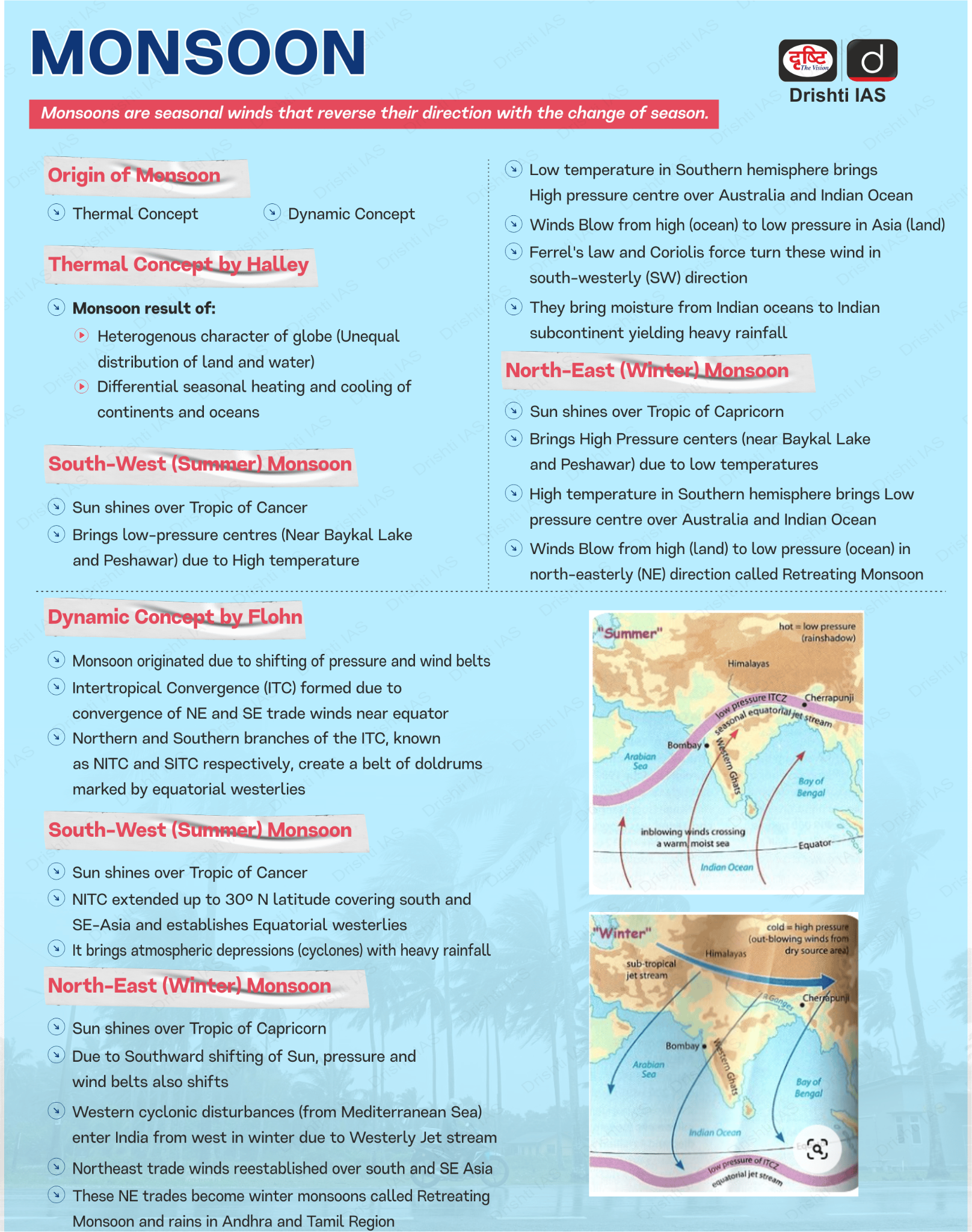Important Facts For Prelims
Impact of Cloud Band on Monsoon
- 26 Mar 2025
- 6 min read
Why in News?
A study by the Indian Institute of Science (IISc) highlights that the strength of a monsoon cloud band plays a crucial role in determining its movement and the intensity of rainfall over the Indian subcontinent.
What are the Findings of the Study on Monsoon Cloud Bands?
- Strength of Cloud Bands: Only strong equatorial cloud bands can move northward and trigger wet spells in India. Weak bands fail to propagate, contradicting earlier models which assumed consistent propagation regardless of strength.
- The study finds that the duration and intensity of wet spells depend on the size and strength of the cloud band and Boreal Summer Intraseasonal Oscillation (BSISO) influences monsoon wet and dry spells by moving cloud bands from the equator to the Indian subcontinent.
- Air-Sea Interaction: Air-sea interactions in the equatorial Indian Ocean are crucial for moisture buildup and wind strength. Stronger coupling enhances atmospheric moisture, intensifying the monsoon.
- Climate Change Impact: A warmer atmosphere will result in higher background moisture, increasing the intensity of wet spells.
- Rainfall during wet spells is projected to increase by 42% to 63% over India and adjoining seas in the future.
- Improving Climate Models: Findings will help improve the efficacy of seasonal and sub-seasonal monsoon forecasting models.
Boreal Summer Intraseasonal Oscillation
- The BSISO is a monsoon pattern that moves convection (heat and cloud activity) from the Indian Ocean to the western Pacific during June - September.
- It controls monsoon’s ‘active’ (rainy) and ‘break’ (dry) phases influencing rainfall, wind patterns, and ocean waves.
- Accurate BSISO predictions help in coastal management and climate forecasting. Its strength and movement are modulated by El Nino Southern Oscillation (ENSO), with La Niña enhancing northward propagation and El Niño weakening it.
What are the Key Facts About India’s Monsoon?
- Etymology: The term "monsoon" is derived from the Arabic word "mausim", meaning season.
- Types of Monsoon in India:
- Southwest Monsoon (June-September): Also known as "advancing monsoon", brings moisture-laden winds from the Indian Ocean.
- Brings heavy rainfall to most parts of India, caused by low pressure over Tibet and high pressure over the Indian Ocean.
- Northeast Monsoon (October-December): Also known as “retreating monsoon”, results from the southward movement of monsoon troughs and the withdrawal of the southwest monsoon.
- Brings rain to southeastern India, especially Tamil Nadu and coastal Andhra Pradesh.
- Southwest Monsoon (June-September): Also known as "advancing monsoon", brings moisture-laden winds from the Indian Ocean.
- Factors Affecting Indian Monsoon: The Inter-Tropical Convergence Zone (ITCZ) shifts northward in summer, creating low pressure over India. The Tibetan Plateau heats up intensely, generating the Tropical Easterly Jet.
- These combined factors pull in moisture-laden winds from the Indian Ocean, triggering the Southwest Monsoon.
- Subtropical westerly jet streams (associated with the northeast monsoon) also regulate monsoon intensity. Additionally, the Somali Jet strengthens the southwest monsoon winds
- The Indian Ocean Dipole (IOD) is a temperature anomaly between the western and eastern Indian Ocean; a positive IOD (warmer west) enhances monsoon and negative IOD weakens it.
- El Niño is often linked with weak monsoons and droughts in India. La Niña typically brings stronger monsoon activity.
UPSC Civil Services Examination, Previous Year Question (PYQ)
Prelims:
Q. With reference to ‘Indian Ocean Dipole (IOD)’ sometimes mentioned in the news while forecasting Indian monsoon, which of the following statements is/are correct? (2017)
- The IOD phenomenon is characterized by a difference in sea surface temperature between tropical Western Indian Ocean and tropical Eastern Pacific Ocean.
- An IOD phenomenon can influence an El Nino’s impact on the monsoon.
Select the correct answer using the code given below:
(a) 1 only
(b) 2 only
(c) Both 1 and 2
(d) Neither 1 nor 2
Ans: (b)
Mains:
Q. How far do you agree that the behavior of the Indian monsoon has been changing due to humanizing landscape? Discuss. (2015)





